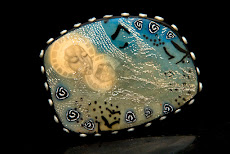For several years I have been asking people, "What would, with complete certainty, cause a viewer to look at adornment pieces and automatically, unhesitatingly identify a collection as distinctly Black American, rather than African? The responses typically begin with moments of silence, then "hmmmmmm I never thought about that" or, "I don't know." Generally, I too describe the silver jewelry, that is sometimes imprinted or stamped with a pattern, using big chunky turquoise stones. Without hesitation the questioned reply, "Native American jewelry" or Southwest Native American jewelry." So, I say, what, without hesitation would cause a viewer to automatically identify a piece of jewelry as Black American?
 |
| Say It Loud Collection, "Paisley Beads" |
During my search and research what stared back at me is the color scheme Red, Black and Green. Marcus Garvey of the Universal Negro Improvement Association is credited with creating this color palette presumably after the release of what became a popular early 1900's song. Written by Will A. Heelan, and J. Fred Helf, "Every Race Has a Flag but the Coon" was popular in the United States and Britain. The song followed the previous success of "All Coons Look Alike to Me", written in 1896 by Ernest Hogan. H. L. Mencken cites it as being one of the three coon songs which "firmly established the term coon in the American vocabulary". A Google search will bring a list of sites, including one from the Library of Congress, addressing these titles.
"Say It Loud" collection is one of several to come that address what immediately comes to my mind when attempting to define a Black American cultural aesthetic. During Black History month of 2014 my assumption felt confirmed when I saw a Black History month catalog. Nearly every item appeared in Red, Black and Green.
"Queen Green Granulation" "kdqCane Swirl Queen"
|
 |
| "Queen Mother", reversible, RBG side |
 |
| "Queen Mother", Adinkra side |
Queendom II Queendom II
 |
| Chevron oval |
 |
| Chevron square |
Chevron Cane Pendant
"kdqCane" small swirl
Ellington Tribute Series, "Black, Brown and Beige"
In Duke Ellington's January 23, 1943 Black Classical music (aka Jazz) symphony performed at Carnegie Hall, he introduced the symphony as "a tone parallel to the history of the Negro in America." In Ellington's thinking the colors Black, Brown and Beige depicted three aspects of Black-American life: "Black," acknowledging faith and hard work; "Brown," acknowledging Negros who served in the Civil War; and "Beige," an homage to the Harlem Renaissance.
 |
| "Ancestor Eye" Series, Pendant |
 |
| Ellington Tribute, sm. Pendant |
"Ancestor Eye" Collection, Queendom I
"Plank Mask Collection"

Reversible Neckpiece
Bracelet
"The Middle Passage" Series
This series represents and pays tribute to the Trans-Atlantic or, "Triangular Slave Trade". The trade formed a triangle from Europe to Africa on to the Americas then back to Europe. That section of the trip from West Africa to the Americas is known as the "Middle Passage". The shape is shown below as bracelets, on a ball chain pendant and as a torque necklace.
Pendant Collection
 |
| Cuff bracelet, brown & beige |
 |
| Ball Chain Sail |
 |
| Cuff bracelet, olive green with Sankofa symbols |
 |
| Torque pendant, olive green |

"Crimson & Cream" Series
Delta Sigma Theta Sorority is one of the oldest African-American collegiate organizations in the U.S. In recognition of their sorority colors this series came into being. And, to the other sororities and fraternities that make up the "Divine 9" stay tuned. . . .
 |
| Homage to Art Smith |



"Collage Series"
 |
| Madonna & Child, transferred image by Rev. Carlos Anderson |
 |
| "Oya", submission to the Yoruba Bead Society |
 |
| "Twigs & Stones" |
"Wawa Abba", reversible
Inspiration for this collection came after much deliberation about what says "African American" in adornment pieces. One day I glanced at my library shelf to see a book I once reviewed for Black Issues Book Review Magazine. The book? Black Hair: Art, Style and Culture by Ima Ebong and A'Lelia Perry Bundles. In that moment this "Locs" Collection came to be. Each neckpeice is one-of-a-kind and individually hand crafted.

You can find details about the life and work of Minnie Evans at Folkstreams .net (see sidebar link at left) and in a book on her work titled "Painting Dreams: Minnie Evans, visionary artist" at Amazon.com.
























